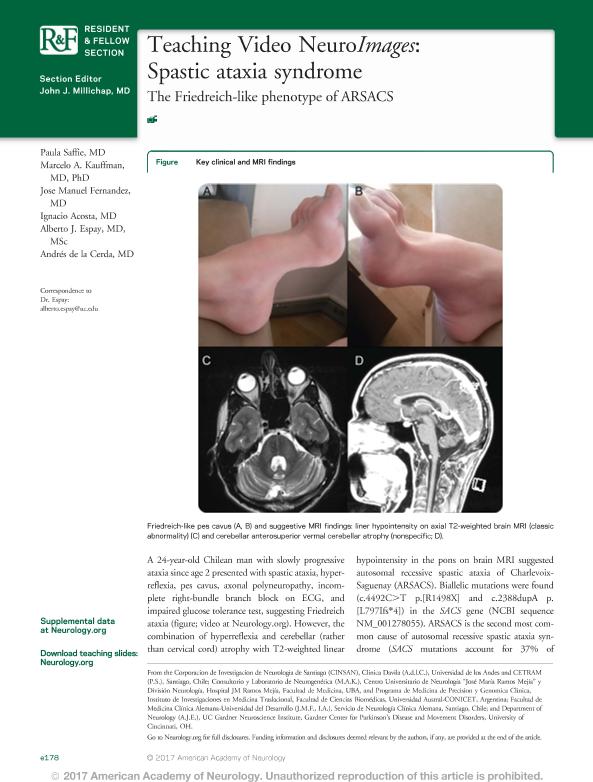Mostrar el registro sencillo del ítem
dc.contributor.author
Saffie, Paula
dc.contributor.author
Kauffman, Marcelo Andres

dc.contributor.author
Fernández, José Manuel

dc.contributor.author
Acosta, Ignacio
dc.contributor.author
Espay, Alberto J.
dc.contributor.author
De La Cerda, Andrés
dc.date.available
2018-05-14T19:38:39Z
dc.date.issued
2017-10
dc.identifier.citation
Saffie, Paula; Kauffman, Marcelo Andres; Fernández, José Manuel; Acosta, Ignacio; Espay, Alberto J.; et al.; Teaching Video Neuro Images: Spastic ataxia syndrome; Lippincott Williams; Neurology; 89; 14; 10-2017; 178-179
dc.identifier.issn
0028-3878
dc.identifier.uri
http://hdl.handle.net/11336/45141
dc.description.abstract
A 24-year-old Chilean man with slowly progressive ataxia since age 2 presented with spastic ataxia, hyperreflexia, pes cavus, axonal polyneuropathy, incomplete right-bundle branch block on ECG, and impaired glucose tolerance test, suggesting Friedreich ataxia (figure; video at Neurology.org). However, the combination of hyperreflexia and cerebellar (rather than cervical cord) atrophy with T2-weighted linear hypointensity in the pons on brain MRI suggested autosomal recessive spastic ataxia of Charlevoix-Saguenay (ARSACS). Biallelic mutations were found (c.4492C>T p.[R1498X] and c.2388dupA p.[L797Ifs*4]) in the SACS gene (NCBI sequence NM_001278055). ARSACS is the second most common cause of autosomal recessive spastic ataxia syndrome (SACS mutations account for 37% of Friedreich-negative cases) and should be considered in any population with suggestive MRI abnormalities.
dc.format
application/pdf
dc.language.iso
eng
dc.publisher
Lippincott Williams

dc.rights
info:eu-repo/semantics/openAccess
dc.rights.uri
https://creativecommons.org/licenses/by-nc-sa/2.5/ar/
dc.subject
Ataxia
dc.subject
Genomics
dc.subject.classification
Medicina Critica y de Emergencia

dc.subject.classification
Medicina Clínica

dc.subject.classification
CIENCIAS MÉDICAS Y DE LA SALUD

dc.title
Teaching Video Neuro Images: Spastic ataxia syndrome
dc.type
info:eu-repo/semantics/article
dc.type
info:ar-repo/semantics/artículo
dc.type
info:eu-repo/semantics/publishedVersion
dc.date.updated
2018-03-27T20:00:42Z
dc.journal.volume
89
dc.journal.number
14
dc.journal.pagination
178-179
dc.journal.pais
Estados Unidos

dc.journal.ciudad
Philadelphia
dc.description.fil
Fil: Saffie, Paula. Universidad de Los Andes, Santiago; Chile
dc.description.fil
Fil: Kauffman, Marcelo Andres. Universidad de Buenos Aires; Argentina. Universidad Austral; Argentina. Consejo Nacional de Investigaciones Científicas y Técnicas; Argentina
dc.description.fil
Fil: Fernández, José Manuel. Universidad del Desarrollo; Chile
dc.description.fil
Fil: Acosta, Ignacio. Universidad del Desarrollo; Chile
dc.description.fil
Fil: Espay, Alberto J.. University of Cincinnati; Estados Unidos
dc.description.fil
Fil: De La Cerda, Andrés. Clinica Davila; Chile
dc.journal.title
Neurology

dc.relation.alternativeid
info:eu-repo/semantics/altIdentifier/doi/http://dx.doi.org/10.1212/WNL.0000000000004556
dc.relation.alternativeid
info:eu-repo/semantics/altIdentifier/url/http://n.neurology.org/content/89/14/e178
Archivos asociados
